52 weeks. 52 different writers. 2 trade paperbacks or hardcovers a week. Each week I’ll take a look at a different writer and read two different collected editions from within that person’s repertoire to help in the examination of their work. This week is a peek at the writer J.M. Dematteis, starting with his work on the recent DC title, Larfleeze.
J.M. DeMatteis
J.M. DeMatteis is a man who has been around the comic industry for quite sometime. He’s done it all at this point, having written for both DC and Marvel as well as many smaller releases under lesser known publishers. DeMatteis is most well known for writing what is perhaps regarded as one of, if not the best Spider-Man stories ever written (more on that one in the next post though!) as well as helping to bring Vertigo, the mature publishing line for DC back in the day, to life. Although DeMatteis’ popularity was at its highest in the 80’s, today we’ll take a look at DeMatteis’ more modern work in that of Larfleeze instead. But why choose something that isn’t as critically acclaimed or well liked as his other work? There’s a simple reason in my eyes and that’s to bring attention to the type of writer Dematteis is…which is an oddball one. In Larfleeze, DeMatteis teams with his frequent co-writer, Keith Giffen. Together the two won an Eisner award many years ago for their mini-series “Formerly Known as the Justice League”. From there they continued on, crafting many other books for “The Big Two” publishers, with their most recent being Justice League 3000. Larfleeze helps to highlight the unique nature of DeMatteis as a writer as he scripts nearly every issue in the series.
Larfleeze: Volume 1 – Revolt Of The Orange Lanterns
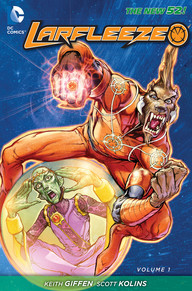 Larfleeze’s solo series follows the sole wielder of the orange light of Avarice throughout his space faring adventures with his reluctant butler, Stargrave. With the help of Stargrave, Larfleeze tries to craft a book recollecting all of his past adventures. When Larfleeze temporarily leaves his current home plant of Okara, Stargrave is assaulted and all of Larfleeze’s treasures are stolen. Larfleeze returns and decides to search high and low to try to recover his lost treasure only to discover it is closer to him than he ever would’ve imagined.
Larfleeze’s solo series follows the sole wielder of the orange light of Avarice throughout his space faring adventures with his reluctant butler, Stargrave. With the help of Stargrave, Larfleeze tries to craft a book recollecting all of his past adventures. When Larfleeze temporarily leaves his current home plant of Okara, Stargrave is assaulted and all of Larfleeze’s treasures are stolen. Larfleeze returns and decides to search high and low to try to recover his lost treasure only to discover it is closer to him than he ever would’ve imagined.
Although that’s how this collection of Larfleeze stories starts, it’s not actually where J.M. DeMatteis comes into play. The initial wave of stories is all written and scripted by Keith Giffen, as all of them are very brief back-up stories from other comics that lace together to setup the Larfleeze solo series. When the volume finally hits issue 1 of Larfleeze, J.M. DeMatteis’ presence on the book is immediately noticeable as he takes over scripting and “kiblitzing” from Keith Giffen, leaving him to do the plotting. Under the direction of DeMatteis’ script, Larfleeze becomes infinitely more interesting as a character and a story.
Larfleeze as an overall character goes through a satisfying character arc here, which shouldn’t be much of a surprise considering the fact that his name is right there on the front of the book. The selfish and greedy nature of Larfleeze is only blown up to even larger proportions as it serves largely as a driving point for much of the adventures he faces. A character firmly rooted in his selfish ways, Larfleeze remains that way for much of the book before he’s finally forced to confront some truths that he’s sheltered from even himself. After going through torture and torment, Larfleeze comes out from it a better character with a stronger understanding of himself. By the end of this volume Larfleeze he circles back around to what makes his character tick but with several new wrinkles that will only enhance the story going forward.
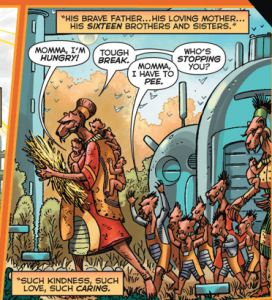
With a character like Larfleeze as your lead, it’s hard to imagine that the story wouldn’t produce even wackier characters and sure enough that’s exactly what DeMatteis cooks up. Larfleeze’s entire personality makes the comic intriguing and it’s only complimented by the addition of his butler, Stargrave. Together the two bring a buddy cop feel to the entire comic as Larfleeze’s selfish nature blends nicely with Stargrave’s sheepish but also self-serving nature as well. It’s their relationship that really serves as the true hook to the story here. Larfleeze hears what Stargrave is saying all the time but rarely listens. As a result, Stargrave usually gets so frustrated that he just gives up and allows Larfleeze to bask in the moment. It’s a dynamic that produces plenty of laughs throughout the entire volume. There’s a plethora of other characters that all have their own distinct personalities as well that are easily displayed ranging from Dyrge of all Sorrows, a depressing powerful being who knows only of unending despair, to the Wanderer who’s thoughts always…ummm…wander.
The dialogue all the way through is plenty up and down as DeMatteis shows as much a knack for writing some characters dialogue as he shows a lack of understanding for a reader’s overall focus. Larfleeze stays consistent as a greedy “God”, always referring to himself in third person and using the word “mine” plenty. Stargrave is a pushover who is always fighting for his own way but quickly submits. The Wanderer often gets lost as her mind is always present in the past and the future, unable to ground itself out in the here and now. All around the dialogue stays strong but on some pages DeMatteis just tries to overload the page with text that doesn’t always do the story any favours. There’s nothing wrong with a wordy page, in all honesty not enough comics do it nowadays, but when the text doesn’t do anything to help enrich the story it ends up just being jargon at times. As a result, sometimes you’ll find yourself reading a page and then having to go back and read it again because it’s such a steady stream of text with space based wording that doesn’t compliment what’s actually happening.
In terms of low points, Larfleeze Volume 1 does hit a few. With DeMatteis scripting, he struggles to find the ability to balance out his scenes correctly. Every issue is riddled with scenes that either run too long, too short or just feel like they don’t belong. Likewise many of the last pages of these issues that should be cliffhangers just fall flat, taking away the sting of that moment you work for by climbing through the issue. The lopsided scenes do hurt the overall story even though DeMatteis still does craft something that’s genuinely interesting. Something else that does hurt DeMatteis’ scripting style is his use of exposition. The first three issues that he scripts are bogged down with exposition that feels unnecessary and, although some of it does compliment the story later on, it’s still an aspect of the story that could have largely been left alone.
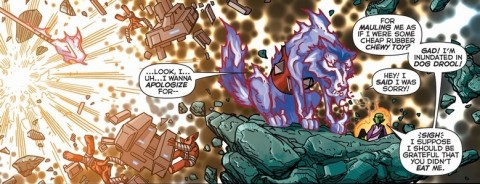
Best Character: Stargrave Pulsar
Best Line Of Dialogue: “I am Stargrave Pulsar–formerly of the planet Colu. Currently wasting his life buttling for a moron.” – Stargrave
Best Moment/Scene: Stargrave bonds with Louis, N’Oden’s pet, over the conflict between their respective masters – Issue 2
Best Issue: Issue 6. The reason I found issue 6 to be the best issue in the collection is due to the manner in which it pulled everything together and resolved many of the plot points from this volume. Larfleeze has some of his sketchy past illuminated which allows him to deal with the present danger at the hands of the Orange Lantern Corps. Tack that on with the setup of the second arc storyline by Wanderer and Stargrave and you’re sure to come back around to read the next series of Larfleeze stories.
Why you should read it: Larfleeze shows the weird side of DeMatteis in a galaxy spanning tale. For the most part you’d probably just pick this volume up because you’re a fan of Larfleeze, which is a perfectly acceptable reason to pick it up. Rest assured that DeMatteis scripts Larfleeze in a manner the does him justice while also adding some fun wrinkles into the character’s history and creating some “unique” characters. You’ll come for Larfleeze but you’ll stay for the buddy cop nature that he shares with Stargrave that results in legitimate laughs. All around Larfleeze is a weird cosmic comic. If you like weird cosmic stuff than this is one you should definitely be giving a try.
Amazing Spider-Man: Kraven’s Last Hunt
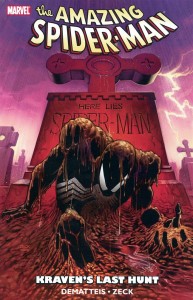 With DeMatteis modeling this story around the Spider-Man universe, he initially felt the need to introduce a new villain for this tale. It wasn’t until he realized the Russian lineage of Kraven that the entire story fell into place and he based it all around The Hunter. Back in 1987 when the story was first published, DeMatteis worked with Mike Zeck to do something that was relatively unheard back then. The terrific twosome took over Web of Spider-Man, Amazing Spider-Man, and The Spectacular Spider-Man for two months, telling Kraven’s Last Hunt across six issues through these three books. Again, this is 1987 we’re talking about here. At that time, as DeMatteis states in his introduction to this story, having an artist and writer take over three books and pump out two issues from each over two months “was revolutionary”. The whole history behind Kraven’s Last Hunt is very interesting and rich, which is why I highly recommend you read the introduction at the front of the trade paperback before delving in with both feet here. It’s so much more than just a fluff piece to hype up the book, it’s genuine and adds a new layer to the reader’s experience.
With DeMatteis modeling this story around the Spider-Man universe, he initially felt the need to introduce a new villain for this tale. It wasn’t until he realized the Russian lineage of Kraven that the entire story fell into place and he based it all around The Hunter. Back in 1987 when the story was first published, DeMatteis worked with Mike Zeck to do something that was relatively unheard back then. The terrific twosome took over Web of Spider-Man, Amazing Spider-Man, and The Spectacular Spider-Man for two months, telling Kraven’s Last Hunt across six issues through these three books. Again, this is 1987 we’re talking about here. At that time, as DeMatteis states in his introduction to this story, having an artist and writer take over three books and pump out two issues from each over two months “was revolutionary”. The whole history behind Kraven’s Last Hunt is very interesting and rich, which is why I highly recommend you read the introduction at the front of the trade paperback before delving in with both feet here. It’s so much more than just a fluff piece to hype up the book, it’s genuine and adds a new layer to the reader’s experience.
The tone of Kraven’s Last Hunt is so wildly different from your average Spider-Man story. It’s dark, grimy and gritty with an edgier Spidey swinging around in the classic black suit. Both Kraven and Spidey speak heavily in monologues during the entire story. It’s the use of captions for these monologues that help elevate the story from standard to fairly incredible. The way DeMatteis writes these captions is in a way that I’ve rarely ever seen done in comics. In many panels you’ll see two different sets of captions, one is often the characters main thought or, as I’ll refer to it for the sake of an example “Caption A”. The secondary set of captions, usually done in a red caption box, are “Caption B”, and reflect the deeper inner thoughts of a character or their emotional state. In one panel you’ll see Spider-Man using Caption A to speak on the situation around him, while Caption B interjects between his next thought proclaiming his fear or anxiety. The end result is your ability to read the text in three different ways, all of which compliment the story. You can read all of Caption A first, followed by all of Caption B or vice versa or read them in tandem as they appear on the page. Then if you factor in the dialogue as well, you’re actually given FOUR different ways to read the page. Each way you read it gives you something different. The best example of this unique writing technique is during issue 4. Peter Parker struggles to free himself from the grave Kraven has buried him in. As he tries to dig his way to freedom, clawing away at the dirt keeping him buried, the scene cuts between the moment Kraven shot him and Peter digging himself free. While he fights to free himself, the top of the panels are lined with Kraven’s dialogue and the bottom of the panels are lined with Peter professing his love to Mary Jane, which is what drives him to survive. It’s an amazing scene that serves as a true high point to the entire series.
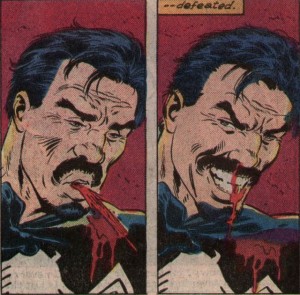
What makes this story so great in my eyes is the fact that it might be more of a Kraven The Hunter story than it is a Spider-Man story. Now think in your head how many good Kraven stories there are out there…I can count them on one hand. The entire idea of this story is to contrast what Peter Parker’s idea of Spider-Man is versus Kraven’s idea of what Spider-Man is. With a new wife in his life, Peter has more to fear causing him to adjust the way he views things slightly. He fears dying more than ever following the sudden death of a low level crook he’s taken on time after time. To Peter, surviving to see Mary Jane another day is what being Spidey has become.
The further you get into the story, the deeper you go into the mind of Kraven. You watch as he starts out believing “the Spider” is something more than a man, only to come around full circle and realize that the Spider is not just any man but a GOOD man. It’s that idea that the essence of the Spider is more spiritual than human that drives Kraven throughout the comic. When Kraven realizes that the Spider is a man instead of a spirit, that’s when he can truly proclaim that he has “defeated” the Spider, as he has already defeated the man that is the Spider. DeMatteis uses the surprising addition of a Captain America villain, Vermin, to help highlight what Kraven believes is Spider-Man versus what Peter believes is Spidey.
On a side note, it’s also worth noting that this story could be considered a precursor to the idea of “Superior Spider-Man”, a recent Spidey story line wherein Doctor Octopus takes over Spidey’s body and tries to be a better Spider-Man than Peter ever was. The reason I draw the comparison is due to the way Kraven speaks throughout the entire story, continually stating that he is a superior version of Spider-Man. It’s an intriguing idea to believe that this story in someway set the stage for Superior Spider-Man as it’s fun to then contrast Kraven’s idea of being a Superior Spider-Man vs. Doctor Octopus’ idea. There are so many parallels between the two villains ideas of superiority that it might be worth a closer look down the road…
I’m a sucker for when comics bookend their arcs. Kraven’s Last Hunt is no exception. During the first issue, a gravedigger is repeatedly seen digging out a grave in the rain for a headstone you can’t quite make out. It isn’t until the end of the issue that you realize this grave is for Spider-Man. Then in issue six that same gravedigger is digging a grave for another character leading up to the final scene of the story. On top of that, in both those issues part of William Blake’s poem “Fearful Symmetry” is recited to close out the issues. It’s a great parallel shared between the two issues and characters that makes the story feel complete.
The one true downside to DeMatteis’ writing of this volume is the lack of consistent dialogue. The use of captions versus the use of dialogue is heavily to the caption side as there’s hardly any meaningful dialogue throughout the entire story. The use of captions in relation to the story are very important, as stated above, but that still doesn’t excuse the weak use of dialogue. Maybe it was a lack of confidence in his ability to dialogue or maybe DeMatteis just felt the inner monologues would suit the story better (which they do) but the heavy use of captions do remind you how close this story was to almost being a Batman book. You can tell from the way Spidey carries himself, especially through the first issue, that DeMatteis wrote this with Batman in the back of his mind the entire time. Even though the captions do give you some vital insight into the character’s minds, stronger dialogue would’ve made this great story even better.
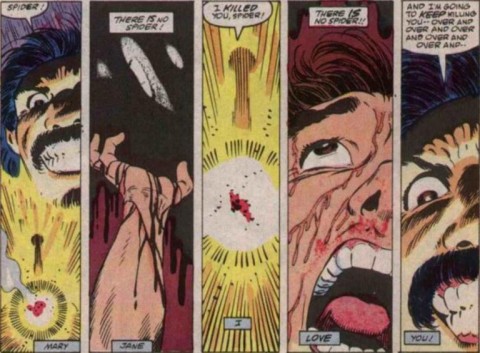
Best Character: Kraven the Hunter
Best Line Of Dialogue or Caption: “Just Peter Parker: That’s my weakness. That’s my strength” – Peter Parker
Best Moment/Scene: Peter Parker freeing himself from his grave – Issue 4
Best Issue: Issue 4 – Resurrection. It was a hard choice between Issue 1 – “Coffin”, Issue 4 -“Resurrection”, and Issue 5 – “Thunder”, as each issue has a moment that could be considered important to Spider-Man history overall. Ultimately though, I settled on choosing Issue 4 for a few reasons. The primary reason is it epitomizes who Peter Parker is in my eyes. After freeing himself from being buried, he immediately returns home to Mary Jane to console her. Peter hardly has anytime with his new wife before he slaps the costume back on to go and deal with Kraven. MJ pleads for him to stay but it’s Peter’s responsibility to figure out whatever Kraven is up to. Perfect Spidey. Add that in with the amazing scene where he is digging his way to freedom earlier in the issue and you’ve got a fantastic issue of Spider-Man.
Why you should read it: Kraven’s Last Hunt is a story about two men, one who is afraid of dying and one who is afraid of failing. Peter Parker fears death more than ever and has so much to lose with a new wife waiting for him at home every night. Kraven fears an inability to prove his superiority. Kraven The Hunter is the best hunter ever but is constantly bested by Spider-Man time and time again, something he just can’t comprehend. But when he asserts his dominance what is left for him? DeMatteis handles all these themes and more as he puts forth what is easily ranked among the top three greatest Spider-Man stories EVER on any given day.


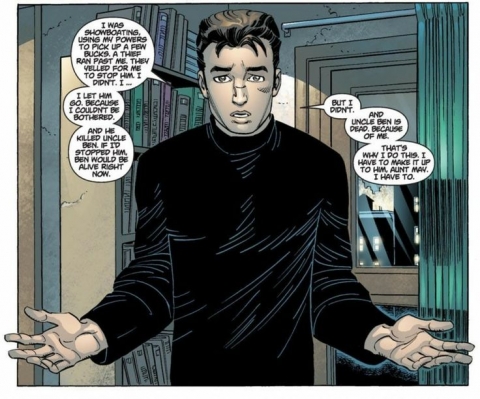
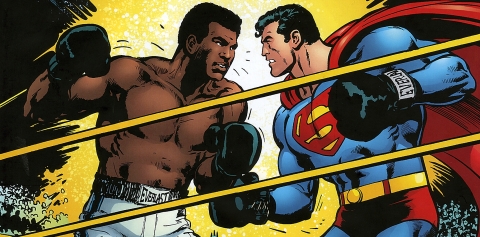
i remember reading the Kraven story when it came out at the time, and thought it was awesome!!